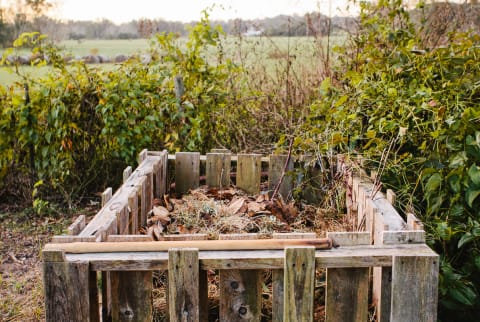Advertisement
Want To Start Composting? 3 Expert-Approved Designs For A Backyard Bin


Home composting feels like it has a higher barrier to entry than other eco-friendly actions, but is that really true? We spoke with Rick Carr, M.S., the director of farm operations at Rodale Institute (an organic agriculture research nonprofit) to see how it can be made more accessible to beginners. And after getting the veteran composter's take, we can confidently say that building a backyard bin doesn't have to be daunting. It turns out, to start a compost pile, all you really need is some outdoor space, wood or wire, and a little bit of patience.
How to make your own compost bin at home.
Composting food and yard waste can massively reduce the amount of trash your household sends to landfill. "Right now, our average U.S. landfill is around 21 to 24% food waste," Carr tells mbg. Once in a landfill, food waste officially becomes "waste"; it breaks down anaerobically (without oxygen) and releases methane, a potent greenhouse gas, in the process.
When composted, this same food isn't a waste product at all. Instead, it's a raw material to be aerobically (with oxygen) broken down into nutrients that are beneficial to the environment. The resulting "black gold" is a soil rich in microorganisms that can help flowers, lawns, trees, and shrubs grow strong.
If you want to set the stage for effective composting, Carr says that reserving enough space is key. You'll want your compost bin to be at least one cubic yard, or 3 feet by 3 feet by 3 feet. "Anything smaller and you'll lose a lot of heat," he explains. Getting your pile up to between 135 and 160 degrees Fahrenheit will fend off viruses and promote decomposition, and it's difficult to do if the surface area-to-volume ratio of your compost is too high.
Carr has found that many backyard compost bins on the market are actually too small to fit this criterion, which is all the more reason to DIY your own. Making your own compost bin will also likely be cheaper and allow you to customize based on your space. Here are Carr's three favorite techniques for doing so, based on the scraps you're adding to it:
For lots of food waste: Square pallet bin
You can buy wooden pallets at a home improvement store or ask around to see if any local businesses are giving them out for free. Look for ones that are at least 3 feet by 3 feet (remember the cubic yard rule!) and have not been treated with pesticides.
Start by standing three up in your yard to form a U-shape, and drill them together to lock them in place. You can leave it at that or add a fourth pallet to make the pile more enclosed. Consider putting the fourth pallet on a hinge so that you can easily access your pile, or add a wire lid to the top of the cube that you can open and close when you want to check on it.
For less food waste: Cylindrical wire mesh bin.
Carr says this is a good option if you're low on space or don't have many scraps to compost. Start with a roll of wire fencing that's at least 3 feet high. Using gloves, arrange the wire in a circle that is at least 3 feet in diameter with some overlap. Then, secure the two ends to each other and close the circle off with zip ties or more wire, or attach them to a stake in the ground.
For yard waste: Underground bin.
OK, this one's less of a bin than a hole. If you're only composting lawn clippings and yard debris, it's as easy as digging a hole in your yard, adding the scraps, and re-covering. "They're not going to attract any rodents," says Carr, and will enrich the soil as they break down over time.
How to tend to it.
This could be a whole other article (and, in fact, it is!) but here is some high-level information about how to keep up with a compost pile now that you have your bin in place:
- For every layer of green (food waste, coffee grounds, yard clippings, etc.) you add to your bin, add twice as much brown (paper towels, paper shreds, coffee filters, cardboard, etc.) on top. According to Carr, leaving your food waste exposed is the No. 1 no-no of composting. Doing so will attract rodents and all sorts of other problems.
- Dampen your brown layer before adding it to make sure your pile has enough water. Don't go overboard, as too much water can cause your pile to smell.
- Aerate your pile by mixing it with a shovel or pitchfork once a week.
- Keep tabs on your bin's temperature with a compost thermometer.
The bottom line.
Buying or making a compost bin is the first step of starting a compost pile at home. If you're going the DIY route, consider using wooden pallets or metal wire for a quick, easy, and effective bin design.